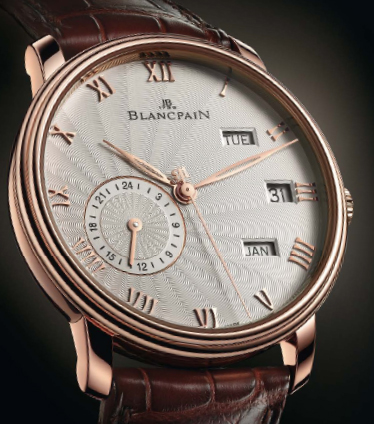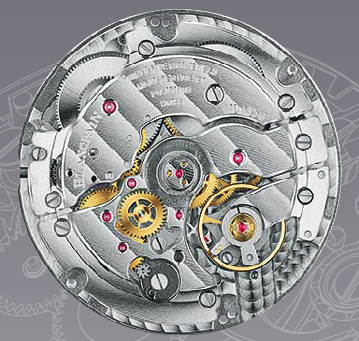Lettres du Brassus - N°09Jeffrey S. Kingston

“Today is Monday, the 31st of January”. That is how people customarily recite a full calendar date. Why is it then that watches customarily don't express or display a date in that way? All too often the date is found in one part of the dial display, the day of the week somewhere else and the month in yet a third place. Disjointed.
Deconstructed if you will. “31” “Monday” “January”. Oh all the information is found on the dial, it's just not arranged as you would say it. Blancpain set out to change that with its Villeret Annual Calendar GMT. All of the date indications are grouped together on the right side of the dial, stacked as you would speak them, day of the week on top, date below, month on the bottom.
Beyond the logic of its arrangement of the date indications in the order in which most would think and speak of them, this new Villeret offers the convenience of an annual calendar. In terms of functionality, an annual calendar nearly equals that of a perpetual calendar in that it accounts for the months which have 30 days. Thus, for all of the months except February, this annual calendar will automatically advance to the first of the next month at the conclusion of the preceding month, regardless of that month's length. This is precisely the benefit derived from a full perpetual calendar. The only departure from the perpetual is that this new annual calendar does not keep track of leap years, which remains the unique province of perpetual. Thus, one time per year, at the end of the month of February, the annual calendar requires the intervention of the owner to advance the watch to the first of March. With that sole exception, all of the “goodness” of a perpetual calendar is found in this new annual model.
Even the exception for the month of February, when a manual advance of the calendar is required, is facilitated with the Villeret Annual Calendar GMT. This is because Blancpain's new timepiece is equipped with Blancpain's exclusive under lug correctors. Whereas the industry norm requires use of a tool to push a corrector located in the sidewalls of the case when a calendar indication is to be set, Blancpain's patented under lug correctors can be manipulated with a finger tip. When the end of February rolls around, in place of a frantic search for that correction tool, the owner simply pushes on the under lug corrector for the date, and the watch is set for another full year, until the next end of February. Moreover, since these easily operated correctors are nestled under the lugs of the watch, the case sides are perfectly clean, unmarred by the usual corrector dimples used by others.

As the name suggests there is even more functionality beyond the annual calendar which has been incorporated into this new Villeret movement, that of a time zone or GMT watch. The dial offers two time displays. Conventional large hour and minute hands and a subdial with a 24 hour indication. The large hour hand can be advanced or retarded in one hour jumps via the crown while the 24 hour hand remains unchanged. This allows for easy setting of the large time display to a new local time zone (presuming that the owner has traveled across time zones and wants to have the watch set to the new local time) leaving the 24 subdial to read home time. This is the perfect arrangement for travelers who want to read local time easily and have a ready reference for home time.
If you are a discerning connoisseur, a question should begin bubbling up in your consciousness. “What happens to the annual calendar when the local time is advanced through midnight?” And, if you are really steeped in the watchmaking art, here should be one other question which pops to mind. Generally speaking complicated calendar mechanisms cannot be turned backwards, so the question would be “What happens to the annual calendar date when the local time is not advanced, but turned backwards past midnight?”
These are more than questions about the design of the movement and how the complex annual calendar and the GMT functions are integrated, they speak to the utility of the timepiece as a travel companion. In the same way that a well designed travel watch should prominently display the local time with the principal time hands, it should also display the local date. This way the watch operates as a “normal” timepiece in the new time zone where the owner has traveled. What one wants to know is the time and date in the current location. Blancpain has always provided this functionality in its Villeret and Leman GMT watches as well in its Leman and L-evolution Réveil watches (and offers this functionality in the new Villeret Half Time Zone watches). The date display in all of those Blancpains has been linked to local time and, if local time is advanced or retarded through midnight, the date moves forwards and backwards appropriately.

This logical linking of the date to local time changes becomes orders of magnitude more challenging to enable when the date indication is made part of a complex calendar such as an annual calendar. As a general rule, advancement of a complicated calendar through linkage to another mechanism such as a GMT is difficult. Retardation of such a calendar, that is to say turning its indications backwards, is extremely difficult.
How difficult? Difficult enough that no annual calendar/GMT combination with the calendar linked to local time has ever been produced before Blancpain's debut of this new Villeret model. One other annual calendar/GMT watch has been offered by another brand, but it simply avoided the challenges of designing its calendar to go forward and backwards by not linking the calendar to the GMT mechanism (local time) and leaving it simply as a date display for home time, which, of course, does not advance or retard with changes in the local time. Blancpain, thus, has achieved a world first with the Villeret Annual Calendar GMT with its forwards and backwards operating calendar linked to the local time of the GMT mechanism.
Enhancing the usefulness of the Annual GMT as a travel companion is its automatic twin mainspring barrel winding base caliber. It offers a full 72 hours of power reserve. A hand finished gold guilloche decorated winding rotor visually contrasts with the hand finished movement, all visible through the sapphire case back.
Of course, as a member of the Villeret collection the guilloche style dial has applied gold Roman numerals matching the color of the 40 mm case. It will be offered in white gold or red gold.







